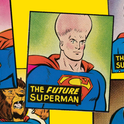Rik Mayall as Alan B'Stard in his satirical TV show The New Statesman ©PA/PA Archive/Press Association Images
Manchester University’s drama department featured an all-star cast in the mid-1970s with Rik, Adrian Edmonson and Ben Elton all in attendance. Also among the faculty was David (Doc) Mayer, a North American lecturer with a passing resemblance to The Cat in the Hat, whose daughter Lise was to become a creator and co-writer of The Young Ones. I was lucky enough to be there, having followed my fellow band members north after abandoning a Chinese degree at Oxford University.
A young Rik Mayall, slouching to lectures, would often approach the scraggly Trotskyite selling newspapers on the steps of the Manchester University Union building. "Morning Star" cried the vendor. "Morning, fan," Rik would reply with a starry wave.
Rik lived in a squalid cottage in South Manchester, the prototype for The Young Ones’ student slum. His double act with Ade was honed in sessions at a local studio where students staged experimental performances. Ben wrote dozens of terrible plays. A few clever kids, chasing higher grades, staged scenes from Shakespeare and Ibsen. The avant-garde Situationist faction performed an alarming version of Waiting for Godot in which a dungareed lesbian tree urinated on Estragon before pulling coloured ribbons out of her vagina. Rik and Ade performed in a group named 20th Century Coyote that saw them hit each other repeatedly with bits of furniture. Footlights it was not.
Over the other side of town, punk bands were playing at the Nile Club, later to become the Factory and produce acts such as Joy Division and the Buzzcocks. I played bass in a blues band. Rik and Ade were regulars. Much alcohol was consumed. That was how we met.
Twentieth Century Coyote took their play, Death on the Toilet, to Edinburgh. The luvvies were underwhelmed. Rik stumbled round America with a touring Oxbridge Shakespeare company, moved to London and lived with his girlfriend, Doc Mayer's daughter Lise, who bullied him into playing at the Comic Strip—a Soho strip club—where he helped invent “alternative comedy” with Nigel Planer, Peter Richardson, Alexei Sayle, Robbie Coltrane and others. Politically correct rants were the norm—an antidote to the working men's club tradition of British stand-up which was often racist and sexist. Rik's preposterous student poet character, Rick, and the shouty slapstick which characterised 20th Century Coyote, were a breath of fresh air. The Comic Strip troupe which later included Dawn French and Jennifer Saunders, plus the musicians Simon Brint and Rowland Rivron (who formed the cult comedy duo Raw Sex) went on to star in the Channel 4 series The Comic Strip Presents a series of self-contained comic films, conceived by Peter Richardson.
In 1981 Rik won a spot on A Kick up the Eighties, a seminal TV sketch show, with one of his finest comic creations, Kevin Turvey, an awkward and socially inept “investigative journalist.” The character's success lead to a one-off “mockumentary” entitled Kevin Turvey, Man Behind the Green Door. Turvey was a sympathetic commentary on the underclass and the meaningless of post-industrial England, inspired by Rik’s experience of growing up in the West Midlands. Rik created the template for later shows such as Steve Coogan's Alan Partridge, while himself being heavily influenced by Peter Cook and Dudley Moore's Pete and Dud, and Tony Hancock, artists he greatly admired, but his portrayal of ennui in a small town where nothing happens owes just as much to Beckett. The university education wasn't entirely wasted.
I moved to London shortly after Rik and Lise—Rowland Rivron and I were drunken wingmen to his swashbuckling promenades up and down Upper Street, Islington, in the pre-gentrification days when there were still real pubs and the occasional gang shooting. Rik's routine was predictable and didn't change much as his fame grew: a few pints, a packet of Silk Cut, erratic games of pool, a curry and a taxi to the notorious members bar Zanzibar in Covent Garden, where rock stars and the new rock stars, alternative comedians, would gather to blather after hours. I was different from the rest—I had a day job, so would often pass out first. Worse yet, I now had a shameful double life working at The Economist, which cut me out further from the herd. But this is not about me, as Rik would no doubt remind me.
Lise cajoled Rik into co-writing The Young Ones and brought in Ben Elton to add more structure to the oddball sketches which became the iconic punk sitcom for which he will be best remembered. The household was based on Rik and Ade's student adventures in Manchester. Its characters; Rick, the preening middle class nincompoop, Neil the hippy, Ade the anarchist, Mike the wannabe wideboy and the psychopath landlord (played by Alexei Sayle) were all familiar campus stereotypes. Rik, Lise and Ben wrote stupid stuff on bits of paper, stuck them together and blocked out the scenes. Paul Jackson at the BBC saw the potential and the rest is history.
Much has been written about why The Young Ones broke so many moulds, but for me, the most important thing is that this absurdist sitcom provided a genuine alternative for a younger generation to middle class comedy shows such as Terry and June, The Good Life or even Fawlty Towers. It was rough and ready, frenetic, cut and paste before the term existed. Teenagers watched the show, with or without parental approval, and still do. It spoke to them, and still does. Ben and Lise developed a game plan as the series progressed, but Rik instinctively knew what the kids liked. For him, the absurd was to be found in the everyday, and he illustrated that at every opportunity.












